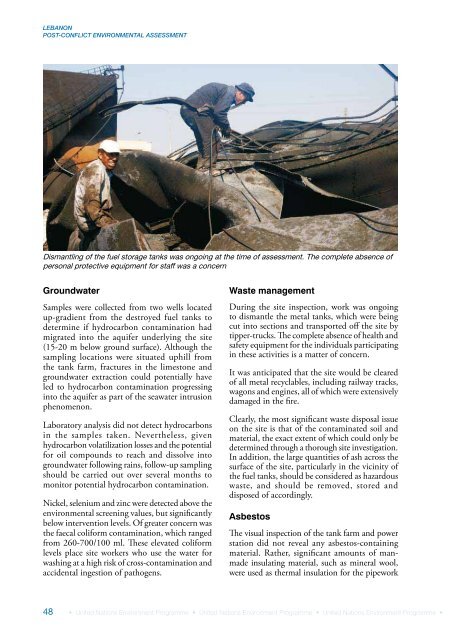Lebanon Post-Conflict Environmental Assessment - UNEP
Lebanon Post-Conflict Environmental Assessment - UNEP
Lebanon Post-Conflict Environmental Assessment - UNEP
Create successful ePaper yourself
Turn your PDF publications into a flip-book with our unique Google optimized e-Paper software.
LEBANONPOST-CONFLICT ENVIRONMENTAL ASSESSMENTDismantling of the fuel storage tanks was ongoing at the time of assessment. The complete absence ofpersonal protective equipment for staff was a concernGroundwaterSamples were collected from two wells locatedup-gradient from the destroyed fuel tanks todetermine if hydrocarbon contamination hadmigrated into the aquifer underlying the site(15-20 m below ground surface). Although thesampling locations were situated uphill fromthe tank farm, fractures in the limestone andgroundwater extraction could potentially haveled to hydrocarbon contamination progressinginto the aquifer as part of the seawater intrusionphenomenon.Laboratory analysis did not detect hydrocarbonsin the samples taken. Nevertheless, givenhydrocarbon volatilization losses and the potentialfor oil compounds to reach and dissolve intogroundwater following rains, follow-up samplingshould be carried out over several months tomonitor potential hydrocarbon contamination.Nickel, selenium and zinc were detected above theenvironmental screening values, but significantlybelow intervention levels. Of greater concern wasthe faecal coliform contamination, which rangedfrom 260-700/100 ml. These elevated coliformlevels place site workers who use the water forwashing at a high risk of cross-contamination andaccidental ingestion of pathogens.Waste managementDuring the site inspection, work was ongoingto dismantle the metal tanks, which were beingcut into sections and transported off the site bytipper-trucks. The complete absence of health andsafety equipment for the individuals participatingin these activities is a matter of concern.It was anticipated that the site would be clearedof all metal recyclables, including railway tracks,wagons and engines, all of which were extensivelydamaged in the fire.Clearly, the most significant waste disposal issueon the site is that of the contaminated soil andmaterial, the exact extent of which could only bedetermined through a thorough site investigation.In addition, the large quantities of ash across thesurface of the site, particularly in the vicinity ofthe fuel tanks, should be considered as hazardouswaste, and should be removed, stored anddisposed of accordingly.AsbestosThe visual inspection of the tank farm and powerstation did not reveal any asbestos-containingmaterial. Rather, significant amounts of manmadeinsulating material, such as mineral wool,were used as thermal insulation for the pipework48 • United Nations Environment Programme • United Nations Environment Programme • United Nations Environment Programme •
















